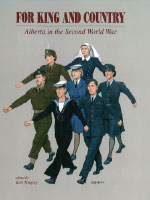Every Kitchen is an Arsenal
Catherine C. Cole
Reprinted with permission of the author and publisher of For King and Country: Alberta in the Second World War Before the war, positions within the company were assigned on the basis of gender: women were seamstresses and "foreladies" while men were machinists and cutters, or "knife pushers" as they were called. Changes in technology paralleled changes in organizational structure; as machinery became lighter-weight and easier to operate, it enabled women to assume positions previously held by men. When men enlisted, women were able to take over these functions for the duration. For example, cutter Louis Kabesh left to join the Navy in 1943 and re-joined the firm after the war.28 During his absence overseas, his job had been performed by women employees.
Before the war, positions within the company were assigned on the basis of gender: women were seamstresses and "foreladies" while men were machinists and cutters, or "knife pushers" as they were called. Changes in technology paralleled changes in organizational structure; as machinery became lighter-weight and easier to operate, it enabled women to assume positions previously held by men. When men enlisted, women were able to take over these functions for the duration. For example, cutter Louis Kabesh left to join the Navy in 1943 and re-joined the firm after the war.28 During his absence overseas, his job had been performed by women employees.
Conclusion
After the jubilant celebrations of V-E and V-J Days, the transition from wartime to peacetime was gradual rather than immediate. While the government continued to issue contracts to GWG to produce clothing for the Netherlands, many women lost their jobs in other industries as men returned to resume their pre-war lives. In voluntary service, women continued to provide "Home Comforts" for the men remaining overseas, assistance to European refugees, and welcoming teas for war brides. An account of the Fort Saskatchewan Women's Institute describes this postwar readjustment.
While it was true the war was over, and things were slowly returning to normal, some changes had been made within the [Alberta Women's] Institute which would remain permanent. One of these was the emphasis placed on overseas relief. The aftermath of war had left such chaos and despair, and such a legacy of human suffering, on a scale which had never before been experienced, that the branches determined to do what they could to alleviate it, in whatever way they could.29
Many of the changes that had been made to Albertan society were permanent, while others such as the lessons of self-sacrifice and frugality were lost as Albertans were encouraged to become greater consumers in order to fuel the post-war economy. For women unable to participate on the battlefront, participation on the home front was a means of supporting their husbands, sons and daughters, and helping to speed victory. The ideal of service - for home, king and country - was a natural expression of the womans' wartime role.
Notes
28. Personal interviews; Louis Kabesh, Lillian Morris.
29. Mrs. C.C. Bodill, op. cit.








